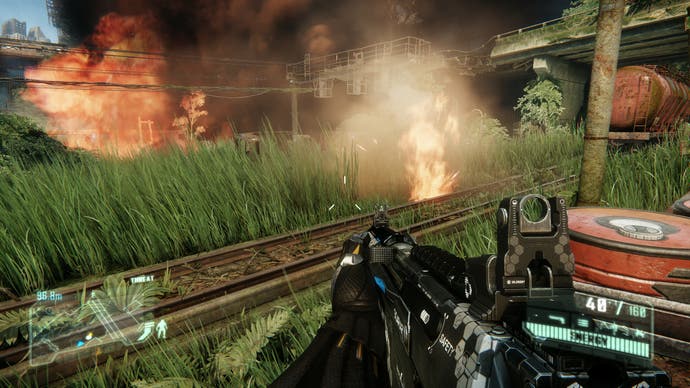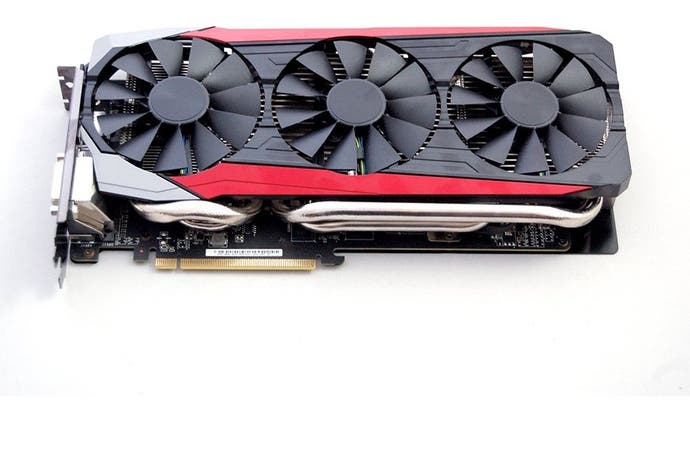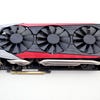AMD Radeon R9 390 8GB review
The heat is on - has Nvidia's GTX 970 finally met its match?
It's an excellent example of how competition drives performance. When Nvidia's GTX 970 arrived, the high-end graphics card market was blown apart. Factory overclocked examples traded blows with Nvidia's prior flagship - the GTX 780 Ti - and performance could be pushed further, bringing it into line with the top-end GTX 980. AMD's Radeon R9 290 and 290X suddenly looked excessively expensive and rather mediocre. Almost a year on and the red team has responded well: it has its limitations, but the performance can't be denied - the new R9 390 8GB is indeed faster than the GTX 970.
AMD's formula for challenging Nvidia's top-end cards is simple enough. The existing Hawaii chips used in R9 290 and 290X are utilised here, receiving an overclock to the GPU core, while the GDDR5 memory modules are replaced with faster, more capable parts with 500gbps of additional bandwidth. It's a simple recipe for success that extracts just enough additional performance on the Radeon R9 390X to make it a contender in its price range, and the formula is arguably even more effective on the R9 390, delivering impressive results up against the GTX 970.
In essence then, the performance is there but it comes at a cost: the Hawaii chip now generates even more heat than it did previously, meaning quite remarkable levels of power consumption. Secondly, dissipating that heat requires a substantial cooling assembly. For our R9 390 8GB review, we're assessing the new Asus DirectCU 3 model - the top-end cooler the company produces, based on top-of-the-line components and boasting beautiful build quality. In fact, it's the exact same set-up used on the firm's R9 Fury card, the difference being that the less capable R9 390 actually produces more heat than AMD's slightly cut-down flagship.
And that's really where the inevitable GTX 970 comparisons should begin. The Nvidia card basically comes in virtually every shape and size available - the model we use is a tiny Zotac version. That product has a miniscule factory overclock (+25MHz to the core), but is more notable for its diminutive dimensions, allowing it to fit inside most of the mini-ITX gaming cases available. We've also had hands-on experience of the MSI Gaming 4G model - very much a standard size GPU, but with the overclocking headroom available to let the product trade blows with a GTX 980, something that the R9 390 is unlikely to be capable of in the majority of games.
- Order the Radeon R9 390 8GB from Amazon with free shipping
In short - while the bulk of this review will centre on the performance, surrounding factors need to be taken into account before we go on. It's bigger and much more power-hungry than the GTX 970 (especially when you venture into overclocking territory), and pumps out a lot more heat, so go into a prospective R9 390 purchase with your eyes open: you need a decent power supply to accompany this card, and decent airflow within the chassis is an absolute must. In these respects, the GTX 970 is a lot more forgiving.
Of course, the AMD challenger does have one additional advantage that shouldn't be overlooked - the inclusion of 8GB of RAM compared to the 3.5/4GB split memory pool set-up of the GTX 970. We won't spend too much time dissecting this (we've done that already) but if you have any VRAM anxiety, whether it's doubts on Nvidia's GTX 970 configuration, or if you want to future-proof yourself from a memory perspective, the R9 390 can't be ignored - especially when performance is this good.
How good? Well, the time-honoured Crysis 3 1080p60 gameplay challenge gives us our first 'real world' indication of the noticeable difference between the R9 390, the GTX 970 and its R9 290 predecessor (our card is a reference model, with fans at a deafening 80 per cent to rule out potential throttling issues). The R9 390 gets very close to providing a properly locked 1080p60 experience, dropping just 156 frames out of an 18,650 sample. It's up there with the R9 390X and edges out GTX 970 while positively shaming the old R9 290.
| Crysis 3 1080p V-Sync Gameplay | R9 390 | R9 390X | GTX 970 | R9 290 |
|---|---|---|---|---|
| Lowest Frame-Rate | 50.0fps | 47.0fps | 44.0fps | 34.0fps |
| Dropped Frames (from 18650 total) | 156 (0.8%) | 107 (0.6%) | 465 (2.5%) | 1347 (7.2%) |
Order the graphics cards tested against the R9 390 from Amazon, with free shipping:
- Radeon R9 290 4GB
- Radeon R9 290X 4GB
- Radeon R9 390X 8GB
- GeForce GTX 970 4GB
- GeForce GTX 980 4GB
- GeForce GTX 980 Ti 6GB
Initial benchmark results at 1080p appear to show that the R9 390 is much of a muchness compared to the Nvidia rival it is designed to supplant. There are convincing wins in AMD favourites Far Cry 4, Ryse and Shadow of Mordor (both around 18 per cent faster) and a decent boost in Crysis 3, but it's slower in Tomb Raider and The Witcher 3. The results are so close we creep into the margin of error on Battlefield 4 and Assassin's Creed Unity. On aggregate, the R9 390 moves ahead of its Nvidia competitor, but only thanks to those three commanding wins on games that historically favour AMD hardware. Bearing in mind its sheer overclockability and how easy it is to unlock that 'free' performance, we'd say that the GTX 970 has the edge at 1080p, where its controversial memory arrangement is unlikely to cause problems - but of course, some gamers don't trust overclocking and prefer to stay at stock speeds.
Comparisons with the R9 390X are revealing. Far Cry 4 runs in a virtually indistinguishable manner, while every game we tested brings home results that see the R9 390 deliver around 93 per cent of the performance of its more expensive sibling. Bearing in mind that the 390X is £100 more expensive, that's quite a remarkable state of affairs and while you may find yourself encountering overheating or stability problems, much of that deficit can be clawed back via overclocking - if you can cope with even higher power consumption and more heat.
Overall then, it's an encouraging start for the R9 390 - 1080p gameplay is the GTX 970's heartland, the area in which it defeated the R9 290 and 290X so comprehensively, and the new R9 390 pulls off the same trick. With all AMD cards tested on the driver released for the 300 series, we see that the hardware enhancements alone account of a 13 per cent boost in performance over the R9 290 and a six point lead over the 290X. There may not be a knockout blow against the GTX 970 here - particularly when decent examples overclock up to GTX 980 levels in many cases - but clearly AMD's new alternative is competitive.
| 1920x1080 (1080p) | R9 390 | R9 390X | GTX 970 | GTX 980 | R9 290 | R9 290X |
|---|---|---|---|---|---|---|
| The Witcher 3, Ultra, HairWorks Off, Custom AA | 53.8 | 57.4 | 56.0 | 65.8 | 47.4 | 50.5 |
| Battlefield 4, Ultra, 4x MSAA | 74.1 | 78.3 | 74.6 | 86.5 | 64.8 | 69.0 |
| Crysis 3, Very High, SMAA | 75.1 | 80.1 | 71.4 | 81.5 | 65.1 | 69.7 |
| Assassin's Creed Unity, Ultra High, FXAA | 51.6 | 56.0 | 51.7 | 62.4 | 46.2 | 50.0 |
| Far Cry 4, Ultra, SMAA | 82.1 | 82.4 | 77.4 | 87.4 | 70.9 | 75.0 |
| Ryse: Son of Rome, High, SMAA | 76.6 | 81.8 | 65.1 | 76.1 | 69.9 | 74.5 |
| Shadow of Mordor, Ultra, High Textures, FXAA | 95.2 | 101.9 | 80.8 | 91.7 | 84.5 | 89.4 |
| Tomb Raider, Ultimate, FXAA | 100.4 | 107.1 | 102.4 | 118.2 | 88.6 | 97.9 |
If you've been following the great AMD vs Nvidia battle at the top tier over the last couple of years, you can probably guess what happens next. AMD's Hawaii-based cards come with a wide 512-bit memory interface, up against the 256-bit bus of the Nvidia Maxwell cards in this sector - the GTX 970 and the GTX 980. As resolution scales upwards, the importance of that hardware element becomes more apparent.
The R9 390 is a good card for 1440p gameplay, and it demonstrates this by taking point on every benchmark (each run at the exact same settings as the 1080p equivalents, where the GTX 970 was more competitive). The gap between the newcomer and the GTX 970 varies on a per game basis: The Witcher 3 and Battlefield 4 barely scrap by with a two to three per cent boost, but other wins are more impressive. Far Cry, Ryse and Shadow of Mordor show gains over 20 per cent, Crysis 3 at 13 per cent and Assassin's Creed Unity and Tomb Raider at five per cent.
At this point, you might expect the GTX 970 to rely on its remarkable overclocking potential to win through. Well, it certainly makes it more competitive in most games, but the effectiveness of its overclocking depends on its dynamic boost clock, which varies from game to game. Crysis 3 with an overclock still can't match the R9 390 at its stock speeds, while Battlefield 4 with the same OC can see it power beyond both R9 390 and 390X, even going toe to toe with the GTX 980.
| 2560x1440 (1440p) | R9 390 | R9 390X | GTX 970 | GTX 980 | R9 290 | R9 290X |
|---|---|---|---|---|---|---|
| The Witcher 3, Ultra, HairWorks Off, Custom AA | 40.3 | 43.5 | 39.2 | 47.5 | 35.6 | 38.2 |
| Battlefield 4, Ultra, 4x MSAA | 51.7 | 54.5 | 48.9 | 57.0 | 44.2 | 47.2 |
| Crysis 3, Very High, SMAA | 48.7 | 52.3 | 43.0 | 50.0 | 42.0 | 44.8 |
| Assassin's Creed Unity, Ultra High, FXAA | 35.5 | 38.4 | 32.8 | 39.7 | 31.4 | 34.4 |
| Far Cry 4, Ultra, SMAA | 64.7 | 69.0 | 53.9 | 61.3 | 52.9 | 57.5 |
| Ryse: Son of Rome, High, SMAA | 57.5 | 62.2 | 46.3 | 54.1 | 52.0 | 55.9 |
| Shadow of Mordor, Ultra, High Textures, FXAA | 69.2 | 74.4 | 57.0 | 66.0 | 61.6 | 65.9 |
| Tomb Raider, Ultimate, FXAA | 69.0 | 75.7 | 65.5 | 76.7 | 61.3 | 67.2 |
As always, 4K turns out to be something of a double-edged sword for AMD hardware. On the one hand, this is where the bandwidth advantages of the Hawaii card set-ups come to the fore, especially so in these new 300 series overclocked renditions, but on the other hand, there's still the sense that there's just not enough rendering power to bring home both the insane pixel count and the visual effects we want to see at decent frame-rates in modern titles. It's a choice between one or the other really. We've posted frame-rate averages here in these benchmarks, but it's worth pointing out that on four titles - AC Unity, Crysis 3, Ryse and The Witcher 3 - frame-rates dip at their lowest below 30fps, even though we've dropped settings down 'one notch' from the 1080p and 1440p tests.
But the reality is that the R9 390 offers some remarkable boosts over the GTX 970. Factor out the 'mere' seven per cent lead in Battlefield 4 (a title Nvidia aggressively optimised to compete against the now deprecated Mantle) and the smallest lead is 14 per cent with Assassin's Creed Unity, while the largest sees both Far Cry 4 and Ryse operate 36 per cent faster. To conclude, 4K benchmarks give AMD an opportunity to comprehensively bash GTX 970 over the head with some big increases, but let's be clear - the practical application of these GPUs at 4K on recent PC titles is fairly limited.
Perhaps the real question here isn't whether the R9 390 should be competing with GTX 970 (in actual fact, it's challenging the GTX 980 here), but whether two cards in CrossFire might be a better option than the R9 Fury X. Certainly there wouldn't be the VRAM anxiety you'd get with 4GB of memory for high-end 4K gameplay. However, the challenge there is of a more practical nature: both R9 390 and 390X are two of the hottest graphics cards we've ever tested - the DirectCU 3 cooler does an excellent job in dissipating the heat from the core, but you still need to get all of that heat out of the chassis. You'll need a meaty power supply, and a big chassis with plenty of fans.
| 3840x2160 (4K) | R9 390 | R9 390X | GTX 970 | GTX 980 | R9 290 | R9 290X |
|---|---|---|---|---|---|---|
| The Witcher 3, High, HairWorks Off, Custom AA | 26.8 | 29.1 | 22.8 | 27.7 | 23.7 | 26.1 |
| Battlefield 4, High, Post-AA | 42.3 | 44.5 | 39.5 | 46.8 | 37.2 | 39.6 |
| Crysis 3, High, SMAA | 38.5 | 40.2 | 31.9 | 39.0 | 33.8 | 36.1 |
| Assassin's Creed Unity, Very High, FXAA | 21.0 | 22.7 | 18.4 | 21.8 | 17.7 | 18.7 |
| Far Cry 4, Very High, SMAA | 40.8 | 44.4 | 30.0 | 36.1 | 34.2 | 37.4 |
| Ryse: Son of Rome, Normal, SMAA | 35.0 | 37.8 | 25.7 | 31.5 | 31.2 | 34.0 |
| Shadow of Mordor, High, High Textures, FXAA | 43.8 | 50.1 | 35.3 | 42.4 | 41.0 | 44.8 |
| Tomb Raider, Ultra, FXAA | 46.6 | 51.4 | 39.0 | 47.1 | 41.3 | 45.9 |
In our Radeon R9 390X review, we shied away from overclocking owing to the extreme levels of power consumption and heat generated when you really pushed the envelope. It's a similar state of affairs here, particularly when Asus has already applied a 50MHz factory overclock. In combination with our 4.6GHz CPU OC, pushing clocks to 1150MHz with the R9 390 caused the system to hit 560W in overall power consumption (!), and we had real trouble getting any kind of stability with the card, requiring us to drop clocks in increments to see how far it could go without crashing. Temperatures were nightmarish too - if we're hitting 85 degrees Celsius with the DirectCU 3 cooler in an open air test-bed, we're going to have problems.
We were finally stable at 1100MHz - (100MHz over reference, 50MHz over the factory overclock). That's a relatively small boost, but it is supplemented by a meaty 600MHz boost to the 8GB of onboard GDDR5. However, that translates to a mere five to seven per cent boost over the factory OC clocks overall. The GTX 970 has much more to offer of course, depending on the game, and there's a night and day difference in terms of efficiency.
Power consumption figures below illustrate starkly how AMD was able to catch up with Nvidia - under load in the same conditions, both at stock and overclocked, the R9 390 consumes a lot more power and emits much more heat: anything from 170W to 190W. That's immense.

| R9 390 | R9 390 OC | GTX 970 | GTX 970 OC | |
|---|---|---|---|---|
| Peak System Power Draw | 447W | 486W | 277W | 291W |
AMD Radeon R9 390 8GB - the Digital Foundry verdict
Before the arrival of the R9 390, it was difficult to recommend anything in this price range other than the default GeForce GTX 970 - by and large, it was faster than everything else AMD had to offer in the same price bracket and not that much more expensive than the clearance stock deals for the R9 290X. With the new card in play, what we're left with are two strong products battling it out at reasonably similar prices, but offering their own strengths and weaknesses.
The R9 390 shakes up the status quo by re-taking the performance crown in this market sector (at reference clocks at least) and addresses VRAM anxiety once and for all with its stupendous 8GB of GDDR5. You may never need it, but it's simply reassuring to know that it's there. For its part, Nvidia continues to bring home the bacon in terms of better driver support (check out those latency spikes on AMD cards in The Witcher 3), more useful GPU-level features and much better power efficiency. The GTX 970 is a physically smaller card in many of its guises, it produces much lower levels of heat, and its overclocking potential is unquestionable. In these areas, AMD isn't at the races, but in a world where out of the box performance is king, perhaps it simply doesn't need to compete in those areas.
Nvidia's bold strike into the £250 GPU market changed everything and with the R9 390 8GB, we finally have a creditable contender from AMD. True, it can't overhaul the core strengths of the GTX 970, but nobody can deny that it comprehensively addresses its perceived weaknesses - a whopping 8GB of GDDR5 will do that. It's a fascinating contest between the two GPUs here, but the real winner is the consumer, who now has two powerful products to choose between in a crucial market sector.

















